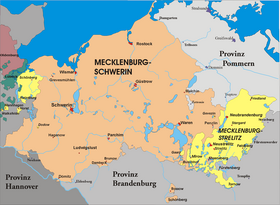House of Mecklenburg
The House of Mecklenburg (also Obodriten ), mainly referred to as the Niklotiden in scientific research , is the dynasty that emerged from the tribal association of the Abodrites and ruled Mecklenburg for a total of 787 years - from 1131 to 1918 - almost continuously . It belonged to the gripping -Gender (the dynasty of the Dukes of Pomerania ), the Silesian Piasts and the Czech Přemyslid the few royal families in the Holy Roman Empire of the German Nation , in the male line of West Slavic descended princes.

historical development
The progenitor of the family is Niklot (around 1100–1160), Prince of the Abodrites , Kessiner and Zirzipans , who fell in 1160 in the battle against Duke Heinrich the Lion . The parentage and origin of Niklot are unknown. His son Pribislaw had to submit to Heinrich after the lost battle of Verchen in 1164, became a Christian and in 1167 received large parts of his paternal inheritance back from Heinrich as a Saxon fief . The Mecklenburg near Wismar (also called Mikelburg, Mikelenburg or Wiligrad) was replaced by Wismar as the princely seat in 1256. In the meantime, however, further princely seats had arisen in the Obodritic dominion. Pribislaw's descendants were appointed dukes in 1348 , and since then all members of the house have held the title of Duke of Mecklenburg . With Albrecht III. the Obodrites also provided a king of Sweden from 1364 to 1389. Sovereign since 1806, they were elevated to grand dukes in two lines (Schwerin and Strelitz) in 1815 and, as such, to ruling federal princes of the German Empire in 1871 , until the November Revolution of 1918.
Partial rule
The Mecklenburg state history is characterized by repeated dynastic divisions, whereby the individual parts of the state remained only limited autonomous members of the Mecklenburg state until 1918 :
1229 First main division of the country into four parts:
- Mecklenburg
- Parchim (until 1316)
-
Werle (until 1436)
- from 1282 Werle-Güstrow and Werle-Parchim
- from 1292–1316 Werle
- from 1316 Werle-Güstrow (until 1436) and Werle-Goldberg (until 1374)
- from 1337 Werle-Waren (until 1425) as a spin-off from Werle-Goldberg
- Rostock (until 1314)
1352 division of the country into two sublords:
- Mecklenburg-Schwerin (I)
- Mecklenburg-Stargard (until 1471)
1621 Second main division of the country into two parts (1628–1631 temporarily united under Wallenstein ):
- Mecklenburg-Schwerin (II)
- Mecklenburg-Güstrow (until 1695)
1701 Third main division of the country into two parts:
In 1815, at the Congress of Vienna , the two Mecklenburg regents received joint titles as Grand Dukes of Mecklenburg . Both parts of the country were henceforth referred to as (partial) grand duchies. Only the state part of Mecklenburg-Schwerin took the step towards a modern constitutional state with a constitutional monarchy in the course of the 1848 reforms, which was ended in 1850 and returned to the old legal status.
After Adolf Friedrich VI. , the last Grand Duke of Mecklenburg [-Strelitz], died shortly before the end of the monarchy in 1918 under puzzling circumstances, the Schwerin Grand Duke Friedrich Franz IV took over the government in Strelitz and finally abdicated on November 14, 1918 for both Mecklenburgs . The former parts of the country achieved political independence as free states for the first time in 1918/19 and remained countries of the German Reich.
The Mecklenburg-Schwerin line expired in 2001 with Friedrich Franz Herzog zu Mecklenburg , the last Hereditary Grand Duke of Mecklenburg-Schwerin, (also in terms of nobility in the male line entitled to the throne). The line Mecklenburg-Strelitz still exists today in the male line; the last male obodrites are the head of the Mecklenburg-Strelitz family, Borwin (* 1956) and his two sons Georg Alexander (* 1991) and Carl Michael (* 1994).
See also
- Family list of the House of Mecklenburg
- Main list of Mecklenburg-Strelitz
- List of the Mecklenburg dukes and grand dukes
Images of the residences of the House of Mecklenburg-Schwerin
Schwerin Castle , residence of the Grand Duchy of Mecklenburg-Schwerin
Ludwigslust Palace , Mecklenburg-Schwerin's summer residence
Stavenhagen Castle
Grambow Castle (near Schwerin)
Raben Steinfeld Castle
Images of the residences of the House of Mecklenburg-Strelitz
Neustrelitz Castle , residence of the Grand Duchy of Mecklenburg-Strelitz
Hohenzieritz Castle , Mecklenburg-Strelitz summer residence
Mirow Palace , Mecklenburg-Strelitz's secondary residence
literature
- Ilka Minneker: From the monastery to the residence. Dynastic memoria and representation in late medieval and early modern Mecklenburg. Rhema-Verlag, Münster 2007, ISBN 978-3-930454-78-5 , ( Symbolic communication and social value systems 18), (At the same time: Münster, Univ., Diss., 2001).
- Almanac de Gotha . Gotha 1936.
Web links
Individual evidence
- ↑ The Duke of Mecklenburg on mecklenburg-strelitz.org
























